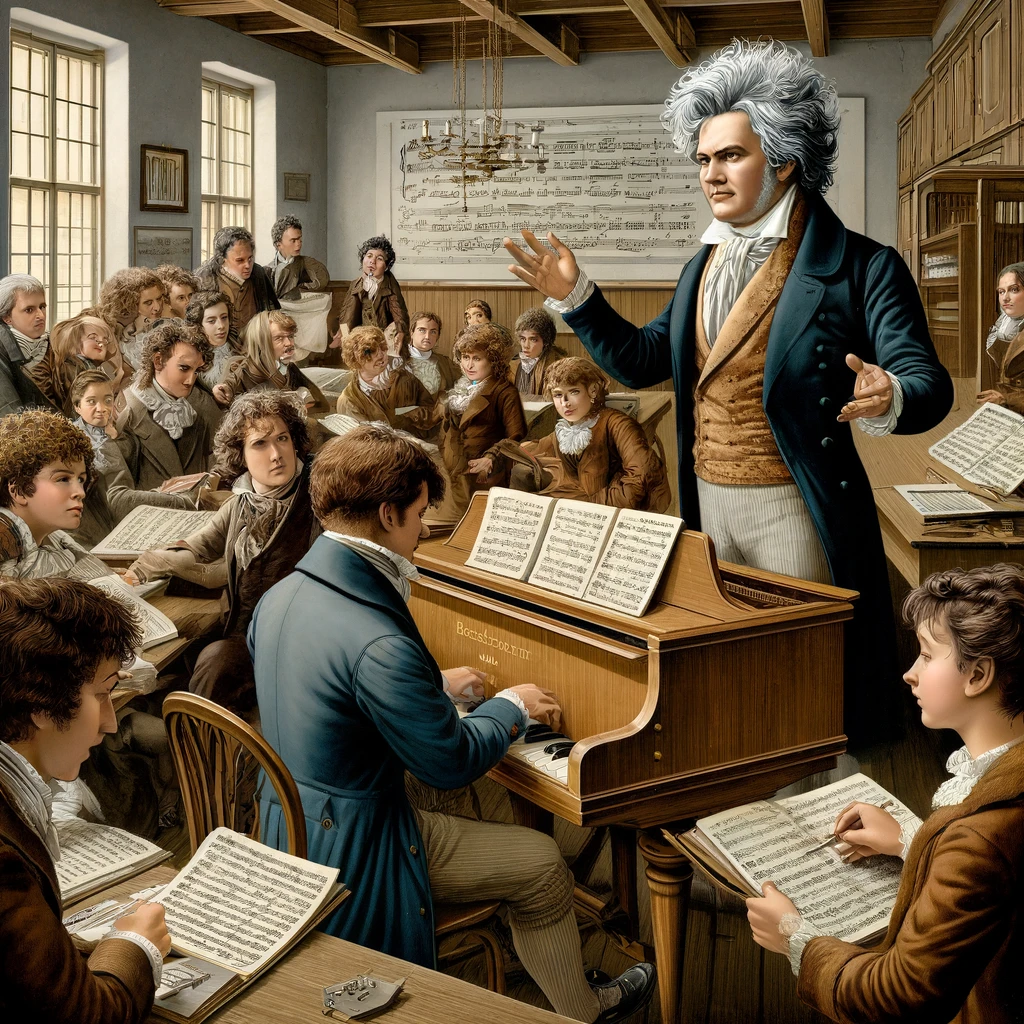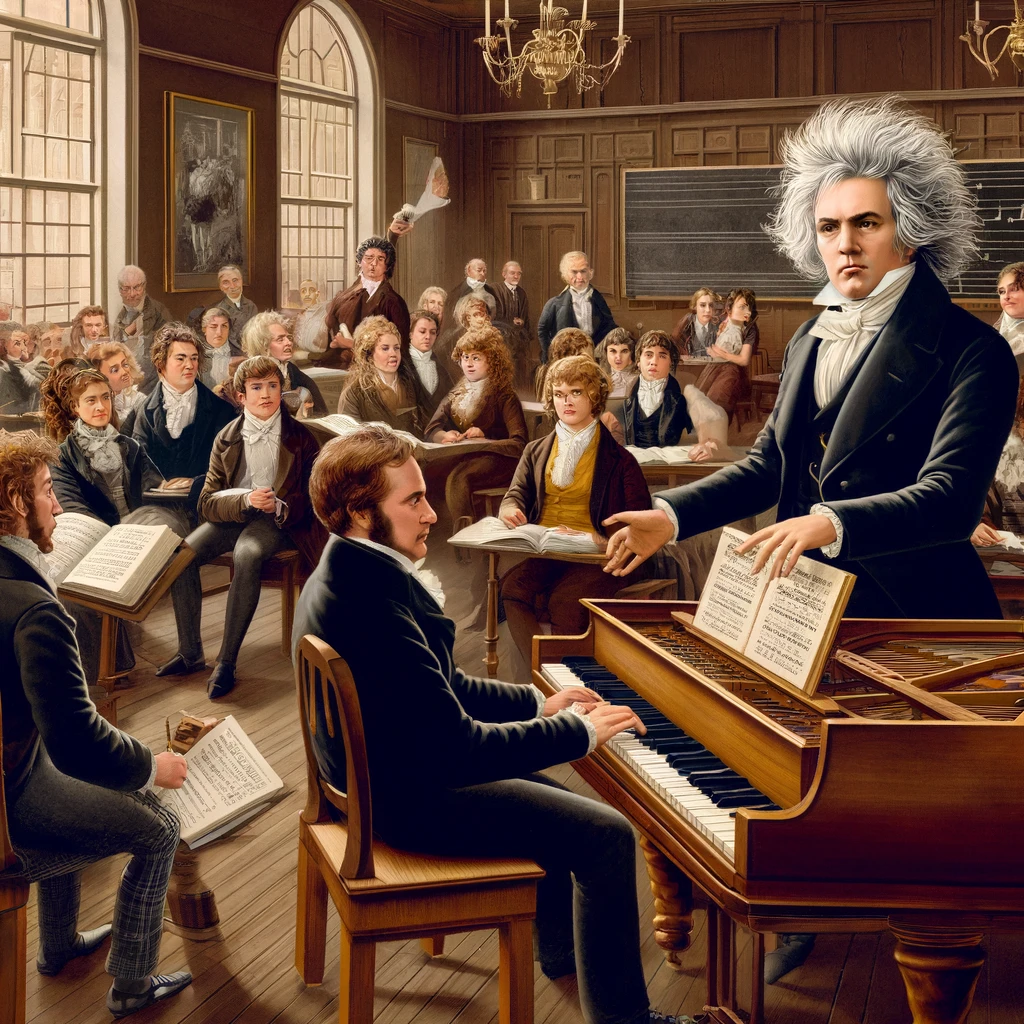
Beethoven’s Impact on Piano Teaching Methods
Ludwig van Beethoven, a towering figure in the world of classical music, has often been celebrated for his symphonies and sonatas. However, his contributions to piano pedagogy — the art and science of teaching piano — are equally profound, though less frequently discussed. This article sheds light on how Beethoven’s musical innovations and teaching methods have shaped modern piano education, providing insights into his lesser-known role as a pedagogue.
Early Influences and Innovations
Beethoven’s approach to piano teaching was significantly influenced by his own musical training and the evolving capabilities of the piano during his lifetime. Born in 1770 in Bonn, Germany, Beethoven’s early musical education was rigorous. His father, Johann, was his first teacher, followed by other local instructors like Christian Gottlob Neefe, who introduced him to the works of Bach and Mozart. This foundation not only shaped Beethoven’s skills as a performer but also his future methodologies in teaching.
The piano itself was undergoing significant changes during Beethoven’s era. The transition from the harpsichord to the fortepiano and eventually to the more robust pianoforte allowed for a greater dynamic range and expressive capabilities. Beethoven exploited these developments to expand the technical and expressive possibilities of piano music. His compositions required a nuanced touch, precise control over dynamics, and an ability to navigate complex emotional landscapes — skills that he emphasized in his teaching.
Teaching Philosophy and Methods
Unlike his contemporaries, Beethoven’s teaching methods were highly personalized. He believed that each student had unique needs and potential, a philosophy that was quite progressive at the time. His approach was not just about imparting technical skills but also nurturing an emotional connection with the music. Beethoven encouraged his students to understand the underlying emotions of the pieces they played, which was a departure from the more mechanical and rote-learning methods prevalent in his time.
Beethoven was known to be a demanding teacher, expecting a high level of dedication and hard work from his students. However, he was also capable of great patience and adaptability, adjusting his teaching style according to the student’s abilities and responses. This adaptive teaching style has influenced modern pedagogical approaches, emphasizing individualized learning plans and the importance of addressing the specific needs of each student.
Compositional Challenges as Pedagogical Tools
Many of Beethoven’s compositions serve as advanced teaching tools. His piano sonatas, for example, are not just musical compositions but also complex exercises that challenge students in specific aspects of piano technique and musical expression. The “Moonlight Sonata,” with its delicate and controlled arpeggios in the first movement, teaches subtlety and dynamic control, while the “Appassionata” is a test of stamina, emotional intensity, and technical precision.
Beethoven’s use of key signatures, thematic development, and structural innovations in these works encourages a deep, analytical engagement with the music, promoting a comprehensive understanding that goes beyond mere performance. His later works, like the “Hammerklavier Sonata,” push the boundaries of piano technique and musical form, serving as capstones to advanced piano study.
Legacy and Influence on Modern Piano Pedagogy
Beethoven’s influence on piano pedagogy can be seen in the way piano is taught today. His emphasis on emotional expression, combined with technical proficiency, is echoed in contemporary teaching. Modern piano pedagogy continues to stress the importance of interpreting the emotional content of the music, encouraging students to develop their own expressive voice.
Moreover, Beethoven’s role in the evolution of the piano concerto and sonata has established a core repertoire that is fundamental to piano education worldwide. His works are not merely exercises in technique but are also imbued with deep philosophical and emotional depth, challenging students to engage both technically and emotionally with the music.
Ludwig van Beethoven’s contributions to piano pedagogy are a testament to his genius not only as a composer but also as an educator. His innovative teaching methods and compositional challenges have left a lasting impact on how piano is taught and learned. By integrating technical skill with emotional expression, Beethoven has shaped the essence of modern piano education, making his methods a core component of classical piano training.
The legacy of Beethoven in piano pedagogy is a blend of rigorous technical mastery and a profound understanding of music as a deeply human art form. As we continue to explore and teach Beethoven’s works, we also continue to learn from his approach to music education, which remains as relevant today as it was in his own time.

Teaching Through Innovation: Beethoven’s Compositional Techniques
Beethoven’s impact on piano pedagogy extends into the realms of innovation in compositional techniques, which he used as a teaching mechanism. He was constantly pushing the boundaries of what was possible on the piano, both in terms of technique and the emotional spectrum. This not only paved the way for future composers but also set new standards in piano teaching.
One notable aspect of Beethoven’s pedagogy through composition is his use of improvisation. Beethoven was a renowned improviser, and his ability to spontaneously create complex and emotionally resonant music impressed many of his contemporaries. He incorporated this element of spontaneity into his teaching, encouraging his students to explore improvisation. This practice helped students develop a personal connection to the music, enhancing their creative expressions and technical versatility.
Structural Complexity and Interpretative Depth
Beethoven’s music often features intricate structures and thematic developments that demand a deep interpretative understanding from the performer. For instance, his late sonatas, like the Sonata No. 31 in A-flat major, Op. 110, demonstrate complex forms that integrate fugues, a baroque form, with classical sonata structures. Teaching these pieces requires a pedagogical approach that not only addresses technical skills but also deep analytical and historical insights.
This blend of structure and emotion in Beethoven’s compositions makes them ideal pedagogical tools for developing a student’s ability to analyze and interpret music deeply. It teaches students not just to play, but to think and feel the music, fostering a holistic understanding that is critical in advanced musical education.
The Role of the Piano in Beethoven’s Pedagogy
Beethoven’s role in the development of the piano as an instrument significantly influenced his teaching methods. His push for more expressive capacity led to enhancements in the instrument’s design, which in turn influenced his compositional style. Works like the “Waldstein Sonata” exploit the full dynamic and sonic range of the piano, challenging students to master control over the newly extended capabilities of the instrument.
This interplay between compositional demands and instrumental capability is a key aspect of Beethoven’s pedagogical influence. By composing music that required an expanded range of the piano, Beethoven effectively set new pedagogical standards that required students to develop a comprehensive technique that included a command over the instrument’s expanding expressive possibilities.
Beethoven’s Educational Legacy
Beethoven’s teaching legacy is perhaps best encapsulated in his role as a mentor to other composers and pianists, such as Carl Czerny, who himself became a significant figure in piano pedagogy. Czerny carried forward Beethoven’s methods, particularly his emphasis on finger independence and agility, which he codified in his own widely used piano studies and exercises. Through his students and their students, Beethoven’s pedagogical principles permeated piano education, influencing teaching approaches worldwide.
Moreover, Beethoven’s broader impact on music education can be seen in his influence on the curriculum of music conservatories, where his works are studied not only for their artistic value but also for their educational merits in teaching musical form, theory, and expression. His music and methods are integral to training students to appreciate and interpret complex musical forms, making them central to classical music education.
Conclusion
Ludwig van Beethoven’s contributions to piano pedagogy resonate through his innovative compositions, challenging piano techniques, and deeply expressive music. His legacy as a teacher is woven into the fabric of music education, where his emphasis on technical proficiency combined with emotional depth continues to influence how piano is taught today.
Beethoven’s role in the evolution of piano pedagogy is a vivid reminder that music education is not just about learning notes and rhythms but about inspiring creativity and deepening our human experience through music. As we continue to engage with his teachings and compositions, Beethoven remains a pivotal figure in not only the history of music but also in the ongoing story of musical education.